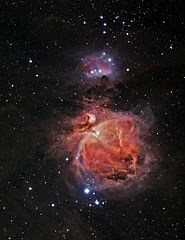NGC 1981
 Miecz Oriona. NGC 1981 znajduje się w górnej części zdjęcia, poniżej leży kompleks mgławic NGC 1977/1975/1973 oraz M42 i M43 (autor: David St. Louis). | |
| Odkrywca | |
|---|---|
| Data odkrycia | 4 stycznia 1827 |
| Dane obserwacyjne (J2000) | |
| Gwiazdozbiór | |
| Typ | otwarta, III2p |
| Rektascensja | 05h 35m 09,0s |
| Deklinacja | –04° 25′ 54″ |
| Odległość | |
| Jasność obserwowana | 4,2 m |
| Rozmiar kątowy | 28,0' |
| Charakterystyka fizyczna | |
| Masa | |
| Wymiary | 7,9 ly (2,42 pc)[2] |
| Alternatywne oznaczenia | |
| OCL 525, C 0532-044 | |
NGC 1981 (również OCL 525) – gromada otwarta znajdująca się w gwiazdozbiorze Oriona. Stanowi północną część asteryzmu zwanego Mieczem Oriona[2]. Należy do Pasa Goulda[2]. Została odkryta 4 stycznia 1827 roku przez Johna Herschela[3]. Jest położona w odległości ok. 1,2 tys. lat świetlnych od Słońca[1]. Jej wiek szacuje się na ok. 5 milionów lat[2].
Zobacz też
Przypisy
- ↑ a b Wilton Dias et al.: Catalog of Optically Visible Open Clusters and Candidates. Departamento de Astronomia, 2014-05-24. [dostęp 2014-11-27].
- ↑ a b c d e F. F. S. Maia, W. J. B. Corradi, J. F. C. Santos Jr. Characterization and photometric membership of the open cluster NGC 1981. „Monthly Notices of the Royal Astronomical Society”. 407 (3), s. 1875-1886, 2010-09-21. DOI: 10.1111/j.1365-2966.2010.17034.x. (ang.).
- ↑ Courtney Seligman: NGC 1981. [w:] Celestial Atlas [on-line]. [dostęp 2014-11-27]. (ang.).
Linki zewnętrzne
- NGC 1981 w serwisie SEDS.org (Revised NGC and IC Catalog) (ang.)
- NGC 1981 w bazie SIMBAD (ang.)
- NGC 1981 w NASA/IPAC Extragalactic Database (ang.)
Media użyte na tej stronie
Autor: David St. Louis, Licencja: CC BY 2.0
M42 - The Great Orion Nebula, taken from the observatory in Elmira.
Image is a composite of an RGB image taken in February 2010 using a modified Canon Rebel XT camera and a Hydrogen Alpha image (as a luminance layer) taken in February 2012 with the QHY9 CCD Camera.
Ha image is composed of three images with total exposures of 2 hours, 30 minutes and 10 minutes - for maximum dynamic range due to the extremes of bright and dark areas in this region.